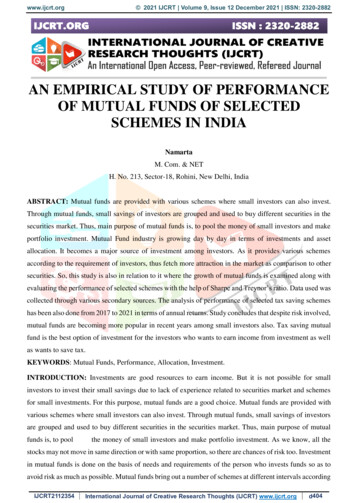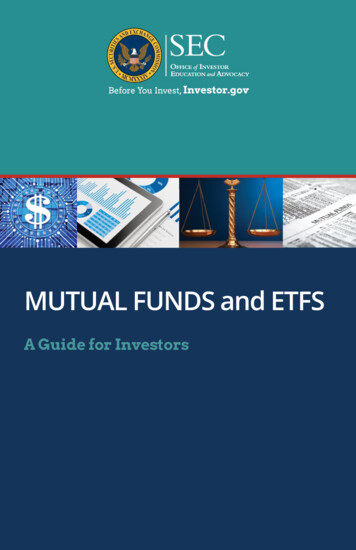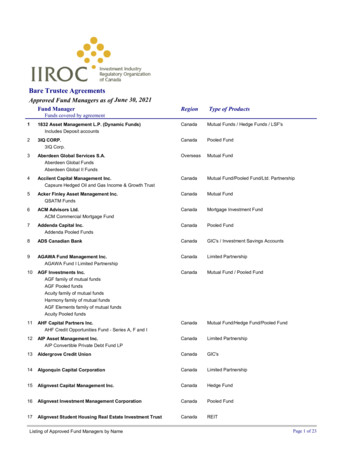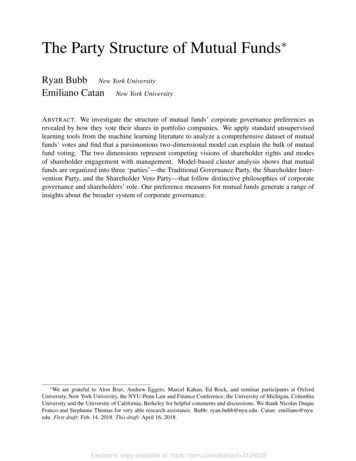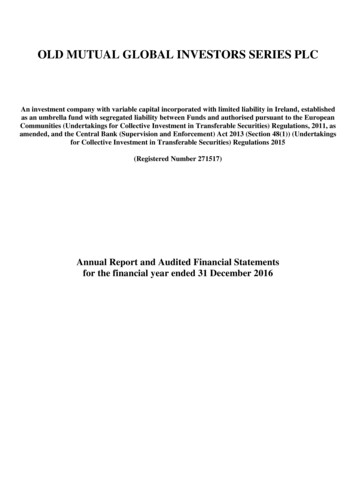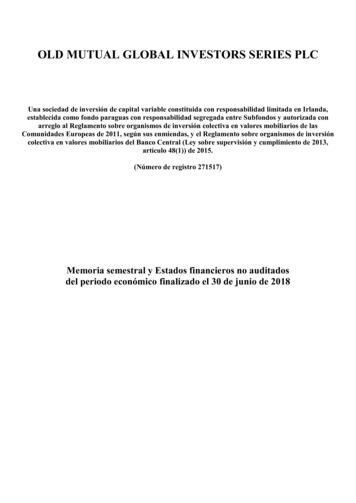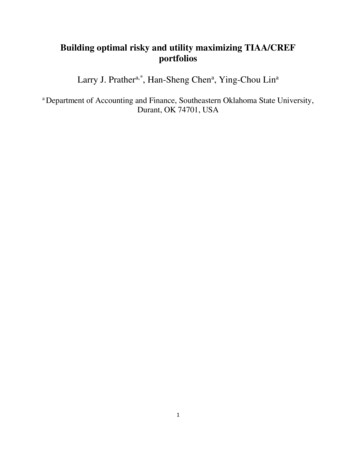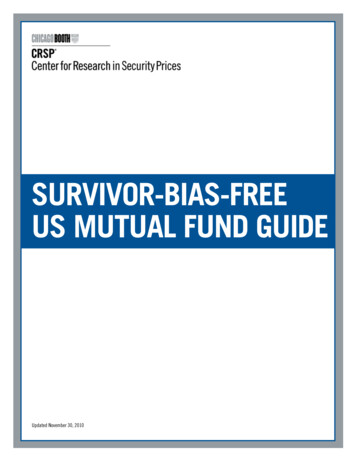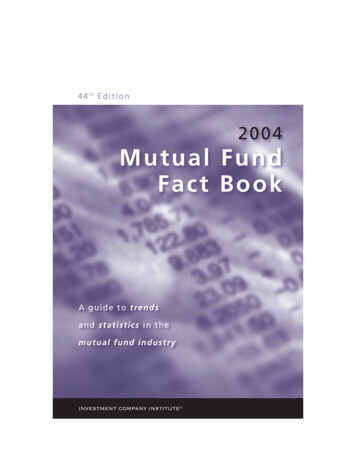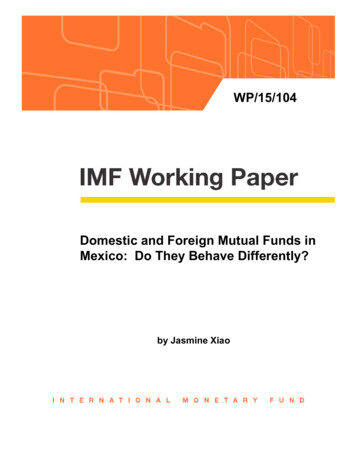
Transcription
WP/15/104Domestic and Foreign Mutual Funds inMexico: Do They Behave Differently?by Jasmine Xiao
2015 International Monetary FundWP/15/104IMF Working PaperMonetary and Capital Markets DepartmentDomestic and Foreign Mutual Funds in Mexico:Do They Behave Differently?1Prepared by Jasmine XiaoAuthorized for distribution by Ulric Erickson von AllmenMay 2015This Working Paper should not be reported as representing the views of the IMF.The views expressed in this Working Paper are those of the author(s) and do not necessarilyrepresent those of the IMF or IMF policy. Working Papers describe research in progress by theauthor(s) and are published to elicit comments and to further debate.AbstractThis paper utilizes a new dataset of foreign and domestic mutual funds in Mexico to assesstheir behavior and obtains three new findings. First, foreign mutual funds are more sensitiveto global financial conditions and engage more in herding and positive feedback trading thandomestic mutual funds, notably during episodes of market stress. Second, the behavior offoreign funds differs substantially across types of funds: bond funds are more sensitive toglobal factors and engage more in positive feedback trading than equity funds; funds sold toretail investors, open-end funds, small funds, and regional funds also appear to be less stablesources of capital flows. Third, there is indicative evidence that foreign funds’ tradingbehavior is associated with higher local market volatilities, notably in periods of marketstress; however, domestic mutual fund investors played some mitigating role.JEL Classification Numbers: F32; G23; G15; G11; G14Keywords: Capital flows; mutual funds; emerging markets; herding; feedback tradingAuthor’s E-Mail Address: yjx20@cam.ac.uk1Jasmine Xiao is a PhD student in Economics at the University of Cambridge. This paper was completed duringher 2014 summer internship in the Monetary and Capital Markets Department. The author is grateful to JianpingZhou for her support and guidance. The paper has benefited from helpful comments and suggestions by Fei Han,Dora Iakova, Hibiki Ichiue, Cheng-Hoon Lim, Robert Rennhack, Miguel Savastano, and seminar participants at theIMF. Some results from this paper have been included in the Selected Issues Paper “Capital Flow Volatility andInvestor Behavior in Mexico” (October 2014).
2ContentsPageI. Introduction . 3II. Overview of Mutual Fund Data . 6III. Correlated Selling and Herding Behavior . 9IV. Global Factors and Positive Feedback Trading . 12V. Effect of Fund Characteristics. 16VI. Do Foreign Flows Affect Market Volatility? . 22VII. Concluding Remarks . 23Figures1. Gross Portfolio Inflows and Cumulative Flows of Mutual (Bond) Funds to . 42. Volatility Clustering in the Mexican Financial Market . 53. Cumulative Bond and Equity Flows for Foreign and Domestic Mutual Funds . 74. Cumulative Bond and Equity Flows for Foreign Mutual Funds by Fund Types. 85. Percentage of Net Sellers among Foreign Mutual Funds . 106. Percentage of Net Sellers (Foreign versus Domestic) During Tapering. 107. Herding among Foreign Equity and Bond Funds Investing in Mexico . 11Tables1. Number of Foreign Mutual Funds Active in Mexico . 32. Percentage of Net Sellers among All Foreign Funds Active in Mexico . 113. Herding Indices for All Foreign Funds Active in Mexico . 124. Evidence on Sensitivities of Fund Flows to VIX (Domestic vs. Foreign Funds) . 145. Evidence on Momentum Trading Behavior (Domestic vs. Foreign Funds) . 156. Percentage of Net Sellers among Foreign Funds by Fund Characteristics . 187. Herding Indices for Foreign Funds by Fund Characteristics . 198. Evidence on Sensitivities of Fund Flows to VIX. 219. Evidence Momentum Trading Behavior . 2110. Excess demand by Foreign & Domestic Mutual Funds and Volatility of Domestic Returns 23AppendicesI. Definition of Fund Characteristics . 25II. Asset Classification for Domestic Mutual Funds . 26III. Construction of the Herding Index . 26IV. Robustness Checks . 28
3I. INTRODUCTIONOne salient feature of financial globalization in Mexico has been the high degree ofparticipation of international mutual funds (Table 1).2 International investors are attracted toMexico for various reasons, such as its reputation as a prudently managed economy, stronglinks with the United States, sound macroeconomic fundamentals, open capital account, andrelatively deep and liquid financial markets. In 2010, Mexico also became the first LatinAmerican country to be included in the Citigroup’s World Government Bond Index (WGBI),attracting new groups of foreign investors.Table 1. Number of Foreign Mutual Funds Active in 020119220129820131192014127Source: EPFR Global.Equity 349111114182927314051587576Bond 2Mexicodedicated2NA666688However, recent episodes of international financial turmoil and the subsequent market jittershave led many observers to question the behavior of international investors and its impact oncapital flows in emerging markets such as Mexico.3 Capital inflows to Mexico contractedsharply during the global financial crisis (2008–09) and after the U.S. Federal Reserve made itsannouncement about tapering in May 2013. For instance, between the first and second quarterof 2013, capital inflows (by non-residents) fell by US 24.5 billion, of which US 14 billion wasdue to a sudden stop in portfolio inflows. Much of this large decline seems to reflect a sharpreduction of foreign mutual funds’ investment in Mexico, especially by the small retail funds(Figure 1).Meanwhile, Mexico has a steadily expanding and diverse domestic investor base. Pension,insurance, and mutual funds now account for about half of the financial system (more than40 percent of GDP). For instance, over the last 10 years, pension funds’ assets have increased2Investors in advanced economies have increasingly sought to diversity their assets by investing in emergingmarkets such as Mexico, often through the so-called Mexico-dedicated funds, or through increased emergingmarket participation by globally active funds.3Frequently, these investors have been seen as overreacting, engaging in momentum trading, exacerbatingvolatility, and aiding in transmitting crises across countries even in the absence of fundamental linkages (Aitken,2007; Furman and Stiglitz, 1998). These views, in turn, have figured prominently in the international policy debateabout the need for capital market regulation.
4by about 18 percent annually, and gradual changes in government regulations have allowedthem to diversify their portfolios and invest abroad.4 While foreign investors rapidly increasedtheir holdings of Mexican government debt, domestic investors have increased their holdings ata much slower pace, and instead, built up their holdings of foreign assets. When portfolioinflows stopped during the global financial crisis, domestic residents retrenched, selling theirforeign assets and bringing the money home.Figure 1. Gross Portfolio Inflows and Cumulative Flows of Mutual (Bond) Funds to MexicoGross Portfolio Inflows (Foreigners)(USD billions; adjusted for errors and omissions)Cumulative Flows of All Bond Funds to Mexico(USD billions)16302514Portfolio Investment1220101581065Stop Episode(Global 013/012013/052013/092014/0140Sources: Haver Analytics and EPFR Global.This paper investigates empirically whether foreign and domestic mutual fund investors inMexico behave differently, and how local market volatility is affected by their behavior,especially during periods of market stress. There are two “stress” episodes in the sample: (i) theheight of the global financial crisis (2008Q3–2009Q3), and (ii) the tapering announcement(2013Q2). Over the past decade, a growing body of research has studied the behavior ofinternational institutional investors, both theoretically and empirically. Theoretical agent-basedmodels often suggest a link between volatility clustering among time series of financial assetreturns and the behavior of market participants (Cont, 2007). Figure 2 plots the volatility ofMexico’s 10-year sovereign bond yields and illustrates clearly the volatility clustering property,i.e., large changes in yields tend to cluster together during the stress periods, resulting inpersistence of the amplitudes of yield changes. Motivated by this property, this paper examineswhether the behavioral hypotheses at the microeconomic level can explain cross-borderportfolio flows and financial volatility phenomena at the macroeconomic level.This paper aims to examine this question using a unique fund flow dataset covering about 400international and 540 domestic mutual funds active in Mexico’s financial markets. The data ismonthly from January 2007 to March 2014 for international mutual funds, and from January4Reforms to the Mexican pension system have strengthened the demand for government securities. Thetransformation in 1997 of the pay-as-you-go system into an individual contributory pension system for privateworkers resulted in a surge of large pension funds. Later on in 2007, the pension system of public employees wentthrough a similar reform which further increased assets managed by pension funds, hence stimulating additionaldemand for securities (see Sidaoui et al., 2012).
52011 to May 2014 for domestic mutual funds.5 The analysis in this paper is divided in threeparts. First, the herding measure introduced by Lakonishok et al. (1992) is used to assess whichof the funds active in Mexico are most likely to exhibit herding behavior, particularly during thestress periods. Second, fund-level panel regression models are estimated to examine howsensitivities of fund flows to global factors differ by fund characteristics. And third, given theevidence on herding and momentum trading, the paper investigates the relationship between anyexcess demand generated by foreign mutual funds’ behavior and the volatility of returns todomestic assets, by regressing the within-month volatility of returns on (lagged) measures ofexcess demand. As the paper focuses on the behavior of mutual funds, care should be taken notto extrapolate its findings to other important segments of Mexico’s financial market, such asbanks, pension funds and insurance companies.Figure 2. Volatility Clustering in the Mexican Financial Market12Volatility of Mexican 10-year bond yields(5-day rolling volatility divided by 5-day rolling average)August 2001 - June 2007June 2007 - June 2009 (GFC)10June2009 - Ma y2013May 2013 - June 2014 (a fter Fed tapering)Linear (June 2007 - June 2009 (GFC))8Linear (May 2013 - June 2014 (after Fed tapering))64200510152025Foreign participation (foreing holdings of LT bondsas a share of total outstanding LT bonds)3035Sources: Bloomberg and Banco de México. See Zhou et al. (2014) for details.This paper contributes to the literature on international portfolio investors in emerging markets,especially to studies that examine the micro-level structures of portfolio flows (Gelos, 2011).Using the measure introduced by Lakonishok et al. (1992), most studies have found evidence ofherding among mutual funds in emerging markets (see, among others, Kim and Wei, 2002;Borensztein and Gelos, 2003; Hsieh et al., 2011). What is less clear is the quantitativesignificance of this behavior, and its magnitude compared to that of other types of investors.65This sample period allows investigation into the behavior of foreign funds during both the global financial crisisand the Fed tapering episodes, but only the behavior of domestic funds in the latter episode.6Two possible forces that can lead to herding behavior are benchmark-based compensation schemes andinformational learning (cascades). The compensation of mutual fund managers is typically linked to theperformance of their portfolios relative to benchmark indices, such as the Morgan Stanley Capital International(MSCI) indices, and JP Morgan’s Emerging Market Bond Indices (EMBI), for equities and bonds respectively inemerging markets. This may create an incentive for fund managers to follow their peers (Basak and Pavlova,2011). Informational cascades–when actions are observable but information is partly private or costly to acquire–can also explain herding and contagion effects in global capital markets (Scharfstein and Stein, 1990; Calvo andMendoza, 2000). In such situations, investors’ actions provide valuable information to others, and in some cases it(continued )
6There is also some evidence of “positive feedback trading” behavior among funds investing inemerging markets, although its quantitative importance is unclear (Kaminsky et al., 2004; Froot,O’Connell, and Seasholes, 2011). Moreover, this growing body of literature has also looked intohow the degree of herding and/or momentum trading varies across different types of investorsand over time. For instance, Hsieh et al. (2011) report that herding among funds investing inAsian markets during the period 1996-2004 emerges particularly during and after crises. In theirstudy on Korea, Kim and Wei (2002) distinguish between resident and nonresident investors.They find that nonresident institutional investors were always positive feedback traders whileresident investors were contrarian traders before the crisis but became positive feedback tradersduring the crisis.The main contributions of this paper are twofold. First, the paper compares the behavior ofdomestic and foreign mutual fund investors in the same market, which provides valuable insightinto their behavior during volatile periods. Second, for foreign mutual funds, this papersystematically investigates the behavior of investors by fund types, exploiting a variety of fundcharacteristics such as investor type, redemption structure, geographic focus, and fund size. Thedistinctive behavior across different types of global portfolio investors implies that changes inthe composition of the investor base in Mexico may potentially have important consequencesfor the stability of aggregate flows.The rest of the paper is organized as follows. Section II describes the datasets and shows thegross cumulative flows by foreign and domestic funds. Sections III and IV examine two aspectsof investor behavior: herding and momentum trading, comparing the behavior of foreign anddomestic mutual fund investors. Section V extends similar analyses to breakdowns of foreignfunds by fund characteristics. Section VI presents direct evidence on the impact of institutionaldemand on the volatility of returns to domestic assets. Section VII concludes.II. OVERVIEW OF MUTUAL FUND DATAThis paper uses two datasets: Emerging Portfolio Fund Research (EPFR) Global for data oninternational mutual funds, and Econometica for data on domestic mutual funds.The EPFR database contains high frequency information about fund flows and asset allocationsthat can be used to construct country flows and sector flows. The funds are split into two broadasset classes: bond and equity funds.7 The entire database includes 11,000 equity funds andmay be optimal for individual investors to completely disregard their own private information and to simply imitatethe behavior of their peers.7EPFR Global covers, in total, 104 developed and emerging countries for equity funds and 108 countries for thebond flows database, tracking more than 95 percent of emerging market focused bond and equity funds. Adrawback of the dataset is that it generally tracks only mutual funds. The number of observations on hedge fundsand others is very limited. However, this is not necessarily critical for studying the behavior of internationalinvestors in emerging markets, since mutual funds have been playing an important role in capital flows to emergingmarket economies. For instance, the share of U.S. investment in emerging markets covered by EPFR Global isabout 58 percent for equities, and more than 42 percent for bonds as of the end of 2012. Moreover, the behavior ofmutual funds itself is an important research agenda, since IMF (2014) reports that they are more sensitive to globalfinancial conditions and are more likely to engage in momentum trading than other types of investors.
74,500 bond funds, all of which had 23.5 trillion in total assets as of March 2014. This paperfocuses on the behavior of the 375 foreign mutual funds active in Mexico since 2007; of these112 are bond funds and 263 are equity funds, with 1.43 trillion in total assets as of March2014. This paper combines two fund-level datasets from EPFR Global: the fund flow data andthe country allocation data. The fund flow dataset reports fund characteristics and their dollardenominated flows, but they are not disaggregated by destination country. In order to examinethe effects of fund characteristics on fund flows and herding behavior, the fund flow dataset ismerged with the country allocation dataset, which reports the destination country allocationweights on a monthly basis, using the unique fund identification number that is common to bothdatasets.8The source of data on Mexico’s domestic mutual funds is Econometica. Covering 546 mutualfunds, the dataset provides the positions of each fund across 68 different types of assets.Notably, this paper distinguishes between foreign and domestic, and under each of the twocategories, assets are aggregated into 5 broader classes: bank deposits, equity, private bonds,sovereign bonds, and others (including derivatives).9 As of May 2014, the total gross assets ofthese domestic funds exceed over 130 billion, approximately half of which is invested indomestic sovereign bonds. To facilitate comparison between domestic and foreign mutualfunds, the rest of the paper focuses on the funds’ positions in domestic equity and bonds(sovereign and private).Fund flows to MexicoFigures 3 and 4 plot the log differences of the gross cumulative flows of bond and equity fundsto Mexico from those in December 2010, which is the first sample point for data on domesticmutual funds.Figure 3. Cumulative Flows to Mexico by Foreign and Domestic Mutual FundsForeign FundsDomestic 012-10-5-2502012-08-2002010-12-150BondsSource: EPFR Global and author’s calculations.Note: The measure of cumulative flows (plotted on the y-axis) is constructed as the log difference of the gross cumulativeflows of bond and equity funds to Mexico from those in the end of 2010, multiplied by 100. The shaded areas indicate thetwo stress episodes in the full sample: the height of the global financial crisis and tapering announcement.89Appendix I lists the fund characteristics identified using the fund flow dataset.Appendix II provides details on the classification of assets.
8Figure 4. Cumulative Flows to Mexico by Foreign Mutual Funds by Fund TypesBonds FundsEquity 12013-052013-092014-01-100Open-endClosed-endBonds FundsOpen-endEquity nds FundsInstitutionalEquity 1-400GlobalLatin America RegionalGlobal Emerging n America RegionalGlobal Emerging MarketsMexico-dedicatedSource: EPFR Global and author’s calculations.Note: The measure of cumulative flows (plotted on the y-axis) is constructed as the log difference of the gross cumulativeflows of bond and equity funds to Mexico from those in the end of 2010, multiplied by 100. The shaded areas indicate thetwo stress episodes in the full sample: the height of the global financial crisis and tapering announcement.Figure 3 shows that the increase in inflows by domestic mutual funds has been much smallerthan the increase in inflows by foreign mutual funds in recent years. Moreover, while foreignmutual funds were selling domestic assets during the stress episodes, there is no clear evidencethat domestic mutual funds were buying these assets at the same time. Among foreign mutualfunds, bond flows to Mexico have increased much faster and have been more volatile thanequity flows. Figure 4 shows foreign funds’ gross cumulative flows to Mexico for different
9types of funds. For both bond and equity funds, this figure suggests a shift in from retail toinstitutional investors that purchase funds investing in Mexico, especially after the globalfinancial crisis. There is also a shift from closed-end to open-end funds, though this seems morepronounced for bond funds than for equity funds. One major difference is that the cumulativeflows from Latin America regional bond funds and global bond funds to Mexico have increasedsignificantly since the beginning of 2011, while equity funds did not experience a similarincrease. This could be attributed to Mexico joining the World Government Bond Index(WGBI) in October 2010. The figure also suggests that the effects of global financial conditionson fund flows seem to differ across types of foreign mutual funds. For instance, during stressepisodes, selling of Mexican assets was more prevalent among open-end funds, funds with retailinvestors, and Latin America regional funds. These types of foreign mutual funds seem to havecontributed more to capital flow volatility in Mexico than other types of funds during the stressepisodes.III. CORRELATED SELLING AND HERDING BEHAVIORThis section uses data on individual fund flows to compute two (related) measures that quantifyco-movements in trading patterns for mutual funds—international or domestic—investing inMexico. First, simple statistics on the proportion of all funds active in Mexico (in a particularmonth) that are net sellers are computed, as this gives prima facie evidence of whethercorrelated selling occurs at times of market stress. Then the herding index introduced byLakonishok et al. (1992) is computed to assess which types of funds are most likely to exhibitherding behavior (i.e., funds moving in the same direction more often than one would expect ifthey traded independently and randomly).Proportion of funds net selling Mexican assetsFigures 5 and 6 show clearly that foreign mutual funds exhibit a strong tendency to sellMexican assets during the periods of heightened global uncertainties. For example, Figure 5shows that when Lehman Brothers collapsed in September 2008, around 75 percent of equityfunds and 95 percent of bond funds active in Mexico were selling Mexican assets. Statisticsreported in Table 2 confirm this observation and suggest that bond fund flows may be morevolatile than equity funds flows during stress episodes. In comparison, correlated selling ismuch weaker among domestic mutual funds: during the tapering announcement in 2013, about50 percent of domestic mutual funds were selling Mexican assets, while the number of netsellers among foreign mutual funds exceeded 70 percent (Figure 6).Looking at the statistics on percentages of net sellers give us some idea about whether and whenfunds (of a particular type) trade in a similar fashion, but they do not allow us to disentangletrends in aggregate inflows (due to, for example, market-wide development in emergingmarkets) from when financial market participants mimic each other’s decisions. The latter isherding: the tendency of funds to move in the same direction (buying or selling) simultaneously,for whatever reason, more often than would be expected if funds were trading randomly andindependently. Such trading behavior can potentially destabilize financial markets, aggravateshocks, and lead to mispricing or asset price bubbles.
10Figure 5. Percentage of Net Sellers among Foreign Mutual Funds (Full Sample)1009080706050403020Portugal -072011-102012-012012-042012-070GreekCrisisBond Funds 2013-072013-102014-01LehmanCollapse10Equity Funds (Foreign)Source: EPFR Global and author’s calculations.Note: The blue and red dotted lines indicate the average percentages of net sellers during normal times over the sampleperiod (2007/01-2014/01) for bond and equity funds, respectively. The shaded areas indicate the specific events thatincreased global uncertainties during the period. The sample averages are calculated excluding the percentages duringthese events.Figure 6. Percentage of Net Sellers (Foreign versus Domestic) During nnouncementBond Funds 13-122014-012014-022014-032070Equity Funds 2013-112013-122014-012014-022014-03Percentage of net sellers100Percentage of net sellers100Bond Funds (Domestic)Equity Funds (Domestic)Source: EPFR Global and author’s calculations.Note: The blue and red dotted lines indicate the average percentages of net sellers during normal times over the period2013/01 – 2014/03 for bond and equity funds, respectively. The shaded area indicates the tapering announcementepisode. The sample averages are calculated excluding the percentages around this time.
11Table 2. Percentage of Net Sellers among All Foreign Mutual Funds in Mexico (in Percent)All Foreign FundsInvesting 69.365.263.5Source: EPFR Global and author’s calculations.Note: Columns (1), (2) and (3) report the average percentages of funds that are net sellers of Mexican assets during noncrisis times, after the collapse of Lehman Brothers (2008/09 – 2008/11), and the period around the taperingannouncement by the Fed (2013/05 – 2013/07).Herding indexThis section constructs the herding measure proposed by Lakonishok et al. (1992).10 Figure 7(left) shows that the proportion of equity investors exhibiting herding behavior in the last10 years is about one half what it was during 2000-2001. The figure also reveals an upwardtrend in herding behavior among equity funds in the second half of the 2000s, which might havebeen caused by the low global interest environment since the mid-2000s.11Figure 7. Herding among Foreign Equity and Bond Funds Investing in Mexico (Percent)8Moreherding7Herding Index654321LessherdingMonth0Equity FundsBond FundsSource: EPFR Global and author’s calculations.Table 3 shows that herding is prevalent among both bond and equity investors, as all the herdinges
This paper utilizes a new dataset of foreign and domestic mutual funds in Mexico to assess their behavior and obtains three new findings. First, foreign mutual funds are more sensitive to global financial conditions and engage more in herding and positive feedback trading than domestic mutual funds, notably during episodes of market stress.
